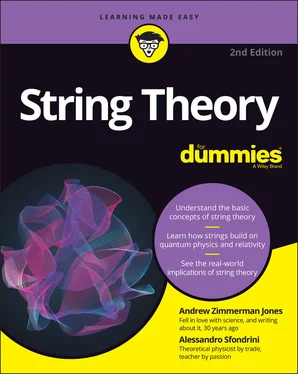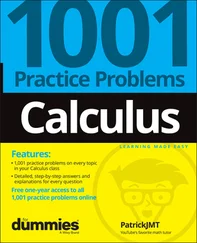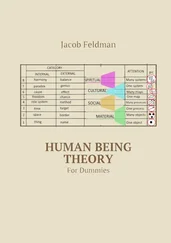For instance, a reasonable quantum gravity should contain the graviton, and it should look like ordinary (classical) gravity when the masses and distances involved have the right size. There are additional requirements that come from quantum physics and are a little more technical. They ensure that the various symmetries of the theory are realized and that all probabilities always add up to 100 percent. (This may sound silly, but it’s one of the most important concepts in quantum theory, called unitarity .)
The hope is that by considering all these constraints, we can pin down what quantum gravity should look like. This approach is sometimes called bootstrapping (as in “pulling yourself up by your own bootstraps”). It’s not clear if the various requirements that physicists have imposed can nail down a single theory of quantum gravity. However, these constraints actually rule out large families of theories, leaving relatively little space beyond string theory.
If this bootstrap approach can be completed, it might eventually show that any reasonable theory of quantum gravity is inevitably string theory. You’ll find more about this approach in Chapter 14, in the section “Bootstrapping Our Way into String Theory”.
Looking into String Theory’s Future
At present, string theory faces two hurdles. The first is the theoretical hurdle, which is whether a model that describes our own universe can be formulated. The second hurdle is the experimental one, because even if string theorists are successful in modeling our universe, they’ll then have to figure out how to make a distinct prediction from the theory that’s testable in some way.
Right now, string theory falls short on both counts, and it’s unclear whether it can ever be formulated in a way that will be uniquely testable. The critics claim that growing disillusionment with string theory is rising among theoretical physicists, while the supporters continue to talk about how string theory is being used to resolve the major questions of the universe.
Only time will tell whether string theory is right or wrong, but regardless of the answer, string theory has driven scientists for years to ask fundamental questions about our universe and explore the answers to those questions in new ways. Even an alternative theory would partly owe its success to the hard work performed by string theorists.
Theoretical complications: Can we figure out string theory?
The current version of string theory is called M-theory. Introduced in 1995, M-theory is a comprehensive theory that includes the five supersymmetric string theories and exists in 11 dimensions. There’s just one problem: By and large, M-theory remains a mystery.
 Scientists are searching for a complete string theory, but they don’t have one yet. And until they do, there’s no way of knowing that they’ll be successful. Until string theorists have a complete theory that describes our universe, the theory could be all smoke and mirrors. Although some aspects of string theory may be shown to be true, it may be that these are only approximations of some more fundamental theory — or it may be that string theory is actually that fundamental theory itself.
Scientists are searching for a complete string theory, but they don’t have one yet. And until they do, there’s no way of knowing that they’ll be successful. Until string theorists have a complete theory that describes our universe, the theory could be all smoke and mirrors. Although some aspects of string theory may be shown to be true, it may be that these are only approximations of some more fundamental theory — or it may be that string theory is actually that fundamental theory itself.
String theory, the driving force of 21st-century theoretical physics, could prove to be nothing more than a mathematical illusion that provides some approximate insights into science but isn’t actually the theory that drives the forces of nature.
It’s unclear how long the search for a theory can last without some specific breakthrough. There’s a sense (among some) that the most brilliant physicists on the planet have been spinning their wheels for decades, with only a handful of significant insights, and even those discoveries don’t seem to lead anywhere specific.
The theoretical implications of string theory are addressed in Chapters 10and 11, while the criticism of the theory rears its ugly head in Chapter 18.
Experimental complications: Can we prove string theory?
Even if a precise version of string theory (or M-theory) is formulated, the question then moves from the theoretical to the experimental realm. Right now, the energy levels that scientists can reach in experiments are probably way too small to realistically test string theory, although aspects of the theory can be tested today.
Theory moves forward with directions from experiment, but the last input that string theory had from experiment was the realization that it failed as a theory in describing the scattering of particles within particle accelerators. The realm string theory claims to explain involves distances so tiny that it’s questionable whether scientists will ever achieve a technology able to probe at that length, so it’s possible that string theory is an inherently untestable theory of nature. (Some versions of string theory do make predictions in testable ranges, however, and string theorists hope that these versions of string theory may apply to our universe.)
You find out some ways to possibly test string theory in Chapter 14, although these are only speculative because right now science doesn’t even have a theory that makes any unique predictions. The best physicists can hope for are some hints that would give some direction to the theoretical search, such as the discovery of certain types of extra dimensions, new cosmological predictions about the formation of our universe, or evidence of the missing supersymmetric particles.
Part 2
The Physics Upon Which String Theory Is Built
IN THIS PART …
Understand the method of science.
Review elements of classical physics.
Apply Einstein’s work in relativity.
Grasp quantum theory basics.
Dive into the Standard Model of particle physics.
Explore cosmology and astrophysics.
Chapter 4
Putting String Theory in Context: Understanding the Method of Science
IN THIS CHAPTER
 Brushing up on scientific theories you know and love
Brushing up on scientific theories you know and love
 So you say you want a scientific revolution
So you say you want a scientific revolution
 What scientists have unified, let no one put asunder
What scientists have unified, let no one put asunder
 Breaking the same old rules to keep things interesting
Breaking the same old rules to keep things interesting
String theory is at the cutting edge of science. It’s a mathematical theory of nature that, at present, makes few predictions that are directly testable by empirical experiments. This brings up the question of what it takes for a theory to be scientific.
In this chapter, we look a bit more closely at the methods scientists use to investigate nature’s structure. We explore how scientists perform science and some of the ways their work is viewed. We certainly don’t solve any big, philosophical issues in this chapter, but our goal is to make it clear that scientists have differing views about how the nature of science is supposed to work. Although we could write volumes on the evolution of scientific thought throughout the ages, we touch on these topics in just enough detail to help you understand some of the arguments in favor of and against string theory.
Читать дальше

 Scientists are searching for a complete string theory, but they don’t have one yet. And until they do, there’s no way of knowing that they’ll be successful. Until string theorists have a complete theory that describes our universe, the theory could be all smoke and mirrors. Although some aspects of string theory may be shown to be true, it may be that these are only approximations of some more fundamental theory — or it may be that string theory is actually that fundamental theory itself.
Scientists are searching for a complete string theory, but they don’t have one yet. And until they do, there’s no way of knowing that they’ll be successful. Until string theorists have a complete theory that describes our universe, the theory could be all smoke and mirrors. Although some aspects of string theory may be shown to be true, it may be that these are only approximations of some more fundamental theory — or it may be that string theory is actually that fundamental theory itself. Brushing up on scientific theories you know and love
Brushing up on scientific theories you know and love










